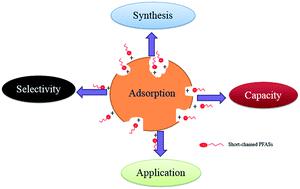当前位置:
X-MOL 学术
›
Environ. Sci.: Water Res. Technol.
›
论文详情
Our official English website, www.x-mol.net, welcomes your
feedback! (Note: you will need to create a separate account there.)
Adsorption of short-chain perfluoroalkyl acids (PFAAs) from water/wastewater
Environmental Science: Water Research & Technology ( IF 3.5 ) Pub Date : 2020-09-29 , DOI: 10.1039/d0ew00468e Chi Thanh Vu 1, 2, 3, 4 , Tingting Wu 1, 2, 3, 4
Environmental Science: Water Research & Technology ( IF 3.5 ) Pub Date : 2020-09-29 , DOI: 10.1039/d0ew00468e Chi Thanh Vu 1, 2, 3, 4 , Tingting Wu 1, 2, 3, 4
Affiliation

|
Since the regulations for the manufacture and use of long-chain PFAAs have become increasingly stringent, there is a tendency to replace them with short-chain homologs. Adsorption is considered the most cost-effective treatment for thermally, chemically, and biologically stable PFAAs. Many types of adsorbents have been synthesized for the removal of short-chain PFAAs. This review therefore provides a summary of adsorbents (synthesis, capacity, and kinetics), mechanisms (uptake mechanisms and influencing factors), and applications, including large-scale setups and point-of-use/point-of-entry (POU/POE) units, for the removal of short-chain PFAAs. Although short-chain PFAAs with their relatively high intraparticle diffusion rates can be more easily removed at the initial stage than the long-chain ones, their low hydrophobicity makes it difficult for them to compete in the long-term with the more hydrophobic organics in the solution (including the long-chain compounds) for binding sites, not to mention the fact that the already adsorbed short-chain PFAAs can be replaced by the long-chain ones. The most commonly applied adsorbents for PFAA removal have been carbonaceous adsorbents. Yet, significant changes are required to alter or modify the main adsorptive mechanism of hydrophobic interaction of carbonaceous adsorbents in order to improve their low removal capacity for short-chain PFAAs in the presence of long-chain compounds. Also, polymeric adsorbents, particularly amine-functionalized ones, are of limitless tunability for selective PFAA removal, which makes them promising for future applications. Future research should also focus on innovative treatment strategies for simultaneous long-chain and short-chain PFAA removal, development of novel adsorbents with better selectivity for short-chain PFAAs, and evaluation under environmentally-relevant conditions.
中文翻译:

水/废水中短链全氟烷基酸(PFAAs)的吸附
由于长链PFAA的生产和使用法规变得越来越严格,因此有一种趋势是用短链同源物代替它们。对于热,化学和生物稳定的PFAA,吸附被认为是最具成本效益的处理方法。合成了许多类型的吸附剂以去除短链PFAA。因此,本综述总结了吸附剂(合成,容量和动力学),机理(吸收机理和影响因素)以及应用,包括大规模设置和使用点/进入点(POU / POE)。 )单位,以删除短链PFAA。尽管具有较高颗粒内扩散速率的短链PFAA在初始阶段比长链PFAA更容易去除,它们的低疏水性使其难以长期与溶液中的更多疏水性有机物(包括长链化合物)竞争结合位点,更不用说已经吸附的短链PFAA可以取而代之的是长链的。用于去除PFAA的最常用吸附剂是碳质吸附剂。然而,需要改变或改变碳质吸附剂疏水相互作用的主要吸附机理的显着变化,以改善它们在长链化合物存在下对短链PFAA的低去除能力。同样,聚合物吸附剂,特别是胺官能化的吸附剂,对于选择性PFAA的去除具有无限的可调性,这使其在未来的应用中大有前途。
更新日期:2020-09-29
中文翻译:

水/废水中短链全氟烷基酸(PFAAs)的吸附
由于长链PFAA的生产和使用法规变得越来越严格,因此有一种趋势是用短链同源物代替它们。对于热,化学和生物稳定的PFAA,吸附被认为是最具成本效益的处理方法。合成了许多类型的吸附剂以去除短链PFAA。因此,本综述总结了吸附剂(合成,容量和动力学),机理(吸收机理和影响因素)以及应用,包括大规模设置和使用点/进入点(POU / POE)。 )单位,以删除短链PFAA。尽管具有较高颗粒内扩散速率的短链PFAA在初始阶段比长链PFAA更容易去除,它们的低疏水性使其难以长期与溶液中的更多疏水性有机物(包括长链化合物)竞争结合位点,更不用说已经吸附的短链PFAA可以取而代之的是长链的。用于去除PFAA的最常用吸附剂是碳质吸附剂。然而,需要改变或改变碳质吸附剂疏水相互作用的主要吸附机理的显着变化,以改善它们在长链化合物存在下对短链PFAA的低去除能力。同样,聚合物吸附剂,特别是胺官能化的吸附剂,对于选择性PFAA的去除具有无限的可调性,这使其在未来的应用中大有前途。











































 京公网安备 11010802027423号
京公网安备 11010802027423号